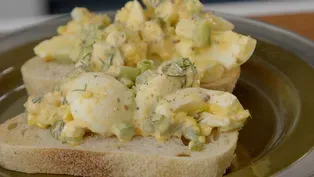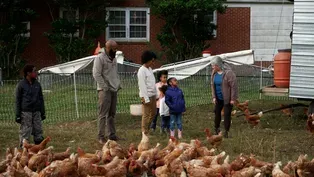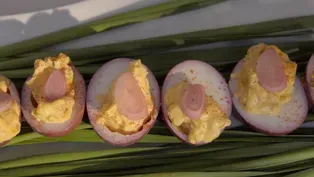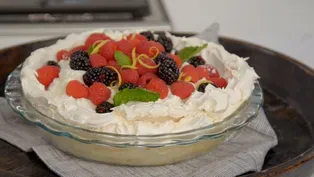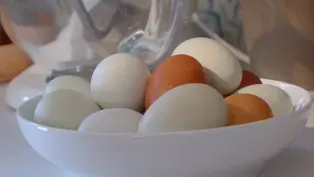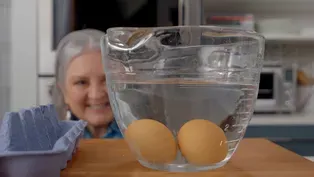
The Egg Comes First
9/11/2023 | 26m 46sVideo has Closed Captions
Food writer Sheri Castle shares her favorite egg recipes.
Which comes first, the chicken or the egg? The egg clearly comes first in Sheri Castle’s lemon angel pie and deviled-egg salad. She rises early with the chickens to gather fresh eggs and cooks with food culture preservationist Gabrielle Carter, who makes Sheri swoon over gorgeous jewel-toned pickled eggs. Sheri also shares a helpful hint on how to quickly assess the freshness of an egg.
Problems playing video? | Closed Captioning Feedback
Problems playing video? | Closed Captioning Feedback
The Key Ingredient is presented by your local public television station.

The Egg Comes First
9/11/2023 | 26m 46sVideo has Closed Captions
Which comes first, the chicken or the egg? The egg clearly comes first in Sheri Castle’s lemon angel pie and deviled-egg salad. She rises early with the chickens to gather fresh eggs and cooks with food culture preservationist Gabrielle Carter, who makes Sheri swoon over gorgeous jewel-toned pickled eggs. Sheri also shares a helpful hint on how to quickly assess the freshness of an egg.
Problems playing video? | Closed Captioning Feedback
How to Watch The Key Ingredient
The Key Ingredient is available to stream on pbs.org and the free PBS App, available on iPhone, Apple TV, Android TV, Android smartphones, Amazon Fire TV, Amazon Fire Tablet, Roku, Samsung Smart TV, and Vizio.
Providing Support for PBS.org
Learn Moreabout PBS online sponsorship- [Sheri] Coming up on "The Key Ingredient," we are on an adventure to find the answer to that age-old question, "Which comes first, the chicken or the egg?"
The egg clearly comes first in my, oh so lovely, lemon angel pie.
And a clever recipe for a scrumptious deviled-egg salad.
The star ingredient of a deviled-egg salad is hard-cooked eggs.
- Oh my goodness.
Well, hello everyone!
- We get up the chickens to gather some eggs.
Does a chicken lay an egg every day?
- [Child] Every day chickens lay eggs.
- [Sheri] Every day?
And a cook along with cultural food preservationist, Gabrielle Carter.
- We don't wanna put hot liquid on our eggs because it'll cook our eggs further and we've already boiled them to perfection.
- [Sheri] That's next.
- I'm Sheri Castle.
I write cookbooks, I write for food magazines, I cook, I teach, and I collect stories.
And my favorite stories are the ones behind our best-loved home recipes.
Can you eat just rice like this?
- You could try.
- All right.
Here we go.
Oh, that's awesome.
I will go out and explore from the ground up the best ingredients that go into some of our most beloved family recipes.
It's all about the food, the flavors, and finding, "The Key Ingredient."
[soft music] I love a good egg and nothing beats farm fresh eggs from the chicken coop for any recipe.
Paige and Darren Jackson raise animals and grow veggies at their family's grass-raised farm.
Today, they're gonna teach me what it's like to have backyard chickens.
And together, the beautiful bounty of that labor.
Hey, y'all, I'm Sheri.
It's so good to meet you.
- Hey, Sheri.
- Hello, hello.
- Thanks for getting up with your chickens with me this morning.
I appreciate it.
- Of course, of course.
Thanks for coming out.
- So tell me where we are.
- So we are in Durham, North Carolina and we're right outside of Downtown Durham, so Bahama area.
- But, yet, you've got this whole chicken kingdom out there?
- Yeah, yeah.
Yeah, yeah, yeah.
- And a lot of other animals too?
- Yup, cows and pigs and some dogs.
Some livestock guardian dogs.
- [Sheri] So how'd y'all get into chickens?
- I say chickens are the gateway drug for farming, 'cause they really are.
- [Sheri] Chickens really did come before the egg, in y'all's case.
- This is true.
- Yes.
- Okay.
All right.
So how many chickens do you have now?
- There's about 250 out here.
- Really?
- Laying hens.
- Just for laying lens.
- So now, I've got a lot of questions.
Now should we go visit some chickens?
- We got to feed the chickens and I think that's the way to learn about 'em.
- Let's go- - Let's go feed 'em.
- [Sheri] Let's go make friends with some chickens.
- All right, let's do it.
- All right, then.
[upbeat music] So what is this here?
- This a mobile coop.
- The chicken bus?
- Yeah.
- I don't know if it's a bus.
- It is a bus.
- But, yeah, sure.
- A chicken wagon.
- Chicken wagon.
Yes, yes.
- Chicken wagon.
Here we go.
And so do they sleep in here at night or come and go when they want?
- So they go in every night and they roost on their own.
I could leave it down and they'll just stay in there until the sun comes up.
- All right.
- Typically, our kids help with the chicken chores.
- Well, let's bring on the kids then.
- All right.
- Okay.
We'll have 'em come out.
- I guess it takes a lot to feed all these chickens though.
- It's almost 75 pounds a day.
- Let the boys did it.
Girls, y'all can do the eggs.
- Yeah.
- Y'all stay back.
- Yeah, I will- - You can do the eggs.
- Yeah.
I seem 'em too that if the chickens are out and about and a bug should come along- - They'll eat it.
- I mean, any bugs that come into the territory, right?
- They're gonna eat it.
- Yeah.
- [Darren] They're gonna eat it.
- Oh my goodness!
Well, hello, everyone.
That's like a clown car of chickens.
They just keep coming out of there.
So then, once they eat and go about their day and then when they're ready to lay eggs they just do it in here?
- Inside of there.
- So they do it all in there?
- Yes.
- [Sheri] Okay, so would this be a good time to gather some eggs?
- It should be a good time.
- [Sheri] Will you show me how to gather eggs?
- Yes!
- All right.
Let's go.
Let's gather some eggs.
So when we collect the eggs, so this side now is gonna come down.
She's gonna show us how.
- All right.
- Here we go.
- [Darren] And just step back and we'll use the one that's empty.
- [Sheri] Oh, wow, so, yes, so that's like the ... - [Darren] They like to lay down on that end.
- I got it.
- What happened [indistinct]?
- Oh, there's a chicken.
- Yeah.
- They're trying- - They're in that bus.
- [Sheri] Oh, you found one.
So do all of your chickens, oh, it's still warm - Yeah, it is.
- Thanks, chicken.
Appreciate that.
- Hey, can you let her grab the eggs, Max?
- They're all up there.
- All right.
- All right.
I'll hold the bucket.
- Okay, let her go- - Oh, you've got such a gentle touch.
- Now if there's a chicken over here you'd have to kinda grab- - Oh, that's what happens.
There you go.
- I'll pay y'all for that one.
- No, no, no, it's all right.
- I think I need to let you guys do this.
- What does dad say?
Don't hold the bucket and collect the eggs.
You got to put them- - Lesson one.
- Yeah.
- Yes.
- You gotta- - It takes two hands to collect it.
Watch them.
Get the bucket.
Get the bucket, Meyer.
- Back up, Sugar.
Hello, ladies.
- Here we go.
You wanna get one?
[kids chattering] Say, "Thank you."
- She didn't break the egg.
You've got the touch, ma'am.
You've got the touch.
- She's been doing this for a while.
She knows.
- So when y'all are gathering for sale, what's your next step?
- So after that, we will take the eggs.
- Take 'em and wash 'em.
- So every egg has a bloom.
- A bloom?
That's what you call that coating.
- Yeah, it's the coating on an egg.
- Okay, if, and I understand that we're all in the habit of refrigerating our eggs, if we don't disturb that bloom- - You don't have refrigerate them.
- You don't have to refrigerate them.
And how long could they stay at room temperature?
- About six months maybe.
- I have had more fun with these eggs.
Sorry, I broke one.
- It's all good.
- But anything like that it does take some, what's the expression?
You got to break some eggs to omelet.
Well, apparently to teach somebody how to gather them, it does.
- There you go.
Yeah.
- All right.
I know you got a lot to do.
I'm gonna head out.
- All right.
- Thank you so much.
- Thanks for- - Yeah.
Thank you.
- Y'all take care.
- Thank you.
- Okay, bye.
- All right.
[soft music] - Today, I am making one of my favorite egg-based recipes.
It's called an Angel pie and it's really sort of like an upside down lemon meringue pie.
We're actually making the shell out of meringue and that's what I'm gonna show you first.
So I am measuring my egg whites to know exactly how many I have because eggs come in different size, which means egg whites are in different size.
And I'm going to add a little bit of cream of tartar, which is actually and acidic thing that is gonna help those egg whites get gorgeously billowy, soft, and cloud-like.
The next thing I'm going to do is I am going to get my sugar ready.
And I am going to add to that a little bit of cornstarch.
That cornstarch is going to help that meringue be crisp and delicious and hold up to the filling.
And we're gonna build it in stages.
Stage one is to beat those egg whites and that cream of tartar until it's frothy.
There we go.
Now my next step is, is I'm going to increase the speed and start putting air.
So I'm gonna let this go maybe a minute until we get to a stage called soft peaks.
And all that means is, is that that meringue is starting to look a little bit white and you're starting to see a little bit of movement of that whisk inside the eggs.
So look how quickly this is coming together and we're starting to get those soft peaks.
Now is when we crank up the speed and start putting in our sugar mixture.
If you add your sugar a tablespoon at a time, that means it's giving it time to dissolve in those egg whites an everything rises together.
And that's it.
We're gonna just keep feeding this in there and magic is happening in this bowl.
We're looking for what's called stiff peaks.
And all that means is is when you pull out some of these egg whites, see how that little top knot stays up there?
That is stiff peaks and that is exactly what we need for this pie shell.
What I have here is a pie plate.
Now I'm gonna take my meringue and plop it into the bowl.
And look at this.
I am going to spread this meringue into the pie plate to make a pie shell.
So see what I'm doing here with my spatula?
I am hollowing out a spot where our filling's going to go and I'm making pretty little dollops and little scallops and whirls and do-lollies around the edge so that this is gonna look pretty.
So what I'm going to do now is put it in the oven to bake.
This is a low temperature oven and I'm gonna let it be in there for about an hour until that you can tell that it's firm on top.
And so while that's in the oven, I'm gonna tidy up and tell you how to make the perfect lemon curd filling.
Lemon curd is a type of eggy custard that we use like jam or preserves.
It's not difficult.
First use a heavy bottomed pan.
Add egg yolks to the pan.
I always push the egg yolks through a mesh sieve into the pan that removes any traces of clinging egg white, the part of the egg most likely to curdle.
Make sure to scrape the bottom to remove as much of the yolk as you can.
While whisking, add the sugar in a slow, steady stream.
Then whisk in some lemon zest and juice.
Lastly, add the chunks of cold butter and turn the heat on medium-high.
Many recipes add butter at the end, but I add it from the get-go, because I find that the slow melting of the cold butter helps protect the delicate egg mixture from the heat as it cooks.
Whisk the mixture together, but then switch to a heatproof spatula while stirring.
Let it cook until the curd is thick, smooth, and begins to form small bubbles around the edge of the pan.
About eight minutes.
Stir slowly and evenly and be patient.
Nothing happens at first, but when the curd begins to thicken, it does set quickly.
Remove the pan from the heat and strain the curd through a mesh sieve into a clean bowl to remove the zest.
Check to see whether it's thick enough to coat the back of a spatula.
If you can wipe away a thin strip of curd and it doesn't close up, your curd is done.
The curd needs to be chilled before I use it, so I gently press a sheet of plastic wrap directly against the surface of the warm curd to prevent a skin forming on top while it's in the fridge.
That's it.
Once you know how to make lemon curd, you can use these same steps to make curd from other types of fresh citrus.
Wasn't that lemon curd easy?
And now, check out this pie shell.
It is completely cool and ready to use.
So let me show you how to do that.
So here is our gorgeous lemon curd.
I'm going to scrape this into our cooled pie shell.
I love how this looks.
It looks line sunshine, doesn't it?
And then, I like to take a little thing called a offset spatula and use that to smooth this into our pie shell right up to the edge.
Just that easy.
What goes on top is simple and delicious.
I whipped some cream and I'm gonna dollop that on top of this pie.
Let's add some color and freshness and even more flavor.
Look at these gorgeous, fresh berries.
You wanna make sure you've rinsed 'em and patted them completely dry.
Make sure I've got some raspberries and enough of everything.
And now, the last thing.
I'm gonna take some fresh mint.
I think fresh mint is irresistible with fresh berries and it goes so well with the lemon.
Last, but not least, lemon.
This baby right here is called a channel zester.
There's holes in the top and instead of the finely-grated zest you get, it pulls ribbons of the zest.
Put your thumb on the bottom of the lemon and make long, slow moves.
Look at these curls.
Look at these curls of zest.
It's magic.
Look at this, friends.
Our Angel pie is heavenly.
[upbeat music] Like me, Gabrielle Carter loves to share food stories from family and friends.
Gabby is passionate about sharing culture through food.
And when it comes to egg recipes, she is sharing an updated classic that is elegant and easy.
[soft music] My friend, I am so happy to be with you today.
- Yes, thank you for coming over.
- Okay, I hear we're pickling eggs, which is one of my favorite things in the world.
Is that true?
- Yes, we are pickling eggs, but we are not doing, like, the traditional pickled eggs.
We are using Hibiscus flowers.
- Oh.
- But then, we're gonna use our pickled eggs to make deviled eggs.
- So tell me how we got to this point.
- Okay.
So this is just water and Hibiscus flowers.
- And these are the Hibiscus.
I love that.
It smells like fruit.
- It's so good.
It's so fruity.
- So this is gonna be both your color and the base of flavor, right?
- Mm-hmm.
We have, like a cup of water in here with the flowers.
We're bringing 'em up to a boil.
We could actually bring this down maybe to a simmer.
- There we go.
Yeah, just chills down.
And then, your vinegar.
I love that you got both the vinegar and the sugar.
So this is gonna be like an agrodolce, like a sweet and tangy thing, right?
- Exactly.
Exactly.
Then, we'll put in our ... - Pickles.
- You know, I put pickling spices in so many things.
I think they're an undervalued thing on the spice aisle.
- Without a doubt.
I mean, like, all the goodness.
Bay leaves are like one of my favorite things in the world.
- Speaking of, bay leaves.
- Oh, throw those in there.
- Can I go ahead?
- Yes.
- All right.
- And I'll go ahead and put the sugar in so we can get that dissolved.
- And then salt and pepper, of course.
- Salt and pepper.
- Hand you the pepper.
- Thank you.
- And may I drop these in so they're- - Yeah, go ahead and drop those in.
Okay, got it.
- They're so pretty.
- That will be beautiful in the jar.
And then, I see ice.
Now let me make a guess on this.
I bet that you need to dilute this brine a little bit to balance everything.
And I bet you use ice 'cause it cools it down quick.
Am I guessing correctly?
- Oh my God, yes.
This is why you're Sheri Castle.
- That's another beauty of ice is it quick cools things.
And to me, they peel cleaner.
Have you found that to be true?
- Oh, yeah, because I've torn up some eggs in my past.
- Oh, yeah.
So we're just gonna stir this until the ice dissolve, right?
And then, I mean, I can smell everything.
Is that a good way of knowing when it's ready is when you can smell all the good stuff in there?
- Well, I learned from my uncle Andrew actually, taste everything.
- All right.
- So we'll know because, honestly, that sugar too, I eyeballed that sugar.
Mm, okay, yeah.
- But right now we're gonna pour it in a jar, right?
- Yes.
So we're gonna get this in our jar.
So I put the brine in first because I wanna make sure that my eggs aren't touching each other when I pour my brine over.
- And why is that?
I don't know this trick.
If they're touching and they've been sitting, the color won't saturate those pieces that are touching.
- I love that tip.
- [Gabrielle] And you'll have a bunch more dimples and discoloration.
And then, we're gonna put our eggs in.
- Okay, do we say anything at this point?
Like, "Have a good day.
Bon Voyage.
We love you."?
- We love you.
- You're precious.
- Thanks for your service.
- Exactly.
- So you just put 'em in your pretty jar.
- Put 'em in the jar.
- And then seal 'em up.
- Seal 'em off.
- [Sheri] And what's the minimum amount of time that these need to spend in their brine?
- Overnight.
- Oh, really?
- Overnight.
- And then up to a week or two?
- I would say they just get better.
Yeah, I would say a week.
Two weeks you're gonna really start to see the color working its way to the middle.
- That's gonna be so beautiful.
- The ones that I, so I brought some.
- Oh, good.
Look at that.
Oh, they're so pretty.
- Aren't they?
- You could take that straight to the table.
We're now gonna take the best pickled eggs in the world and make the best deviled eggs in the world.
- You better stop it.
- Let's do it.
Just fish those babies out there.
These have been in here overnight.
- [Sheri] Look at the color.
- [Gabrielle] The color is really beautiful.
- Oh my gosh, they look like jewels.
They really do.
That's amazing.
I would never have guessed that Hibiscus would give that intensity of color.
Can I move this out of your way?
- Yeah.
We could move that to the side.
- All right.
All right, so if we're making deviled eggs, do we start out like normal?
Just cut them in half and- - Yeah.
- Let's see how this is gonna look.
Oh, it's like ombre.
Look at that.
That rim of the purple and the white.
That is gorgeous.
May I help you put yolks?
Are we just- - Yes, please.
- popping the yolks out?
- We're just gonna pop the yolks.
- And then, I'm gonna put the whites over here.
So we've got our little whites, we've got our yolks out here.
And what do we have here?
- We have Dijon mustard, some sweet relish, some hot sauce.
- Always hot sauce.
- Always hot sauce.
And then, this is what makes these eggs a little special too is the Calabrian chili.
- [Sheri] That's putting a devil-y pepper in the deviled eggs.
- You know, it really puts the devil right in 'em.
- [Sheri] 'Cause, you know, I love that you got all these things, because I think that there are a million valid ways to make deviled eggs, but the one thing is they cannot be bland.
- Hot sauce.
- And, you know, that's adding vinegar and pepper.
I love hot sauce in deviled eggs.
A little salt and pepper.
- [Gabrielle] Got a little salt and pepper.
- I can't wait to see what you think of putting the mayonnaise in last.
If you think that that is an improvement or if I need to be perpetually reformed and never do it again.
That is so beautiful.
- That looks great.
- And now, a little chili?
Do you say that was your final?
- And then, a little Calabrian chili.
- Gorgeous.
Just gorgeous.
All right, are we ready to fill these babies?
- I think we are ready.
- That is so pretty.
I love that chili oil, how it's draping down- - So beautiful.
- the side here.
- Such a pretty tray.
- Are you a paprika duster?
Yay or nay?
- I am a paprika duster.
- All right.
I love that you're using smoked paprika.
That last little layer of favor for those chilies.
That is so good.
Love that.
That is so beautiful.
- Always thinking about serving.
- Always thinking about serving.
'Cause although people will eat 'em straight out of that plastic thing- - Oh, honey, I will at them right off of whatever you give them to me in.
- Well, I think it's time to taste one.
- Okay, yeah.
- All right.
One, two, three, here, friend.
- Ting.
- Ting.
[soft music] Oh my goodness, there are 1,000 things going on, but they all get along.
- Mm-hmm.
- And nobody is gonna not know this is a deviled egg.
You didn't stay true to the core, but it's interesting.
Okay, do we get to cook together again sometime?
- Yes, please.
- I would love it.
But for right now, we're just gonna stay here and eat eggs, right?
- Oh, let's eat eggs.
- Okay, 'cause as we know, no matter how many there, there's not too many.
[soft music] I cannot wait to tell you about this egg salad.
It is deviled egg salad 'cause I include everything that I love in a good deviled egg.
I'm gonna start with the dressing, which begins with a little bit of mayo.
Just a little bit on the end of a spoon.
And then, I'm gonna add mustard.
My pick for this mustard is this whole grain Dijon mustard so that these little seeds can be part of the texture of my filling.
And then, I'm gonna add a generous shake of hot sauce.
Then, we have a little bit of sugar, which balances everything.
A tiny bit of paprika and then seasoning salt.
You know, seasoning salt is one of the handiest things you can keep in your kitchen 'cause it's like giving out half of our spice drawer all at one time.
Some grinds of great pepper.
So see, we're building flavor with each ingredient.
Now, I put lemon in my deviled eggs.
I'm going to add a little bit of this delicious zest.
And then, for added measure, just a couple of drops of lemon juice.
Remember that gorgeous dill I was chopping?
In it goes.
Now the star of this show, of course, is going to be hard-cooked eggs.
Lucky for you, I have a foolproof way of doing that and I'm gonna show you how.
Perfectly cooked eggs are key to great egg salad and other recipes too.
We usually call them hard-boiled, but I prefer to say hard cooked as a reminder that the egg should never actively boil at all.
Just bring a big saucepan of water, about three quarts or so, to boil in a large pot.
Yes, that's a lot of water, but it helps.
Gently lower the eggs into the boiling water, cover, reduce the heat to low, and simmer gently for 12 minutes.
If you can hear the eggs bumping around, the heat is too high.
We want to cook them only long enough for the yolks to turn solid.
Overcooking is what turns the outside of the yolks an unsightly green.
Immediately transfer the eggs to a bowl of ice water and let cool for 15 minutes before peeling.
I have great luck with this technique, although sometimes, despite doing everything just right, the egg whites can tear or rough up a little bit, especially when I'm making a platter of deviled eggs to take somewhere it seems.
But that's the beauty of deviled egg salad.
It always looks and tastes fantastic.
So look what I'm doing with our perfectly hard cooked eggs.
I am crumbling them into the bowl instead of mashing them with a fork.
That's one of the things that makes this egg salad so special and so different from most.
We've got big pieces of egg that's going to go with this delicious dressing.
Nothing soft, nothing mushy about it.
And then, I'm going to add two things for color, crunch, and even more interest.
You can use any crunchy vegetables that you like, but my two favorite, time after time, are some scallions and some celery.
Little bits of delicious, crunchy, bright green celery.
And then I'm gonna fold this together.
I'm going to make sure it's thoroughly coated, but I'm not gonna work it too hard.
We want to stir this and fold this only until everything is coated with the dressing and we have this beautiful bowl of delicious deviled egg salad.
Now you can make this a day ahead, but there is no way I'm gonna wait an entire day to taste this.
Let's check on this toast.
It looks perfect and it is ready for this egg salad.
You know, you can do a little bit so that you can pick it up with your fingers or you can do a lot and take after this with a knife and fork.
Now let's take a bite.
Mm, friends, that is so good.
And you've got that crunchy toast, but the star are the eggs.
They're buttery, they're warm, they're delicate, but yet, they're not boring.
This is exceptionally good egg salad that's gonna remind you of your favorite deviled eggs, but look how much easier this was to do.
This is a keeper.
[playful music] One of the things that I love about eggs is that they can keep well for weeks in the fridge, making them a handy staple ingredient in the kitchen.
When I want to hard cook eggs, I always opt for eggs that are at least a couple of weeks old, maybe as much as a month or so.
It's easy to lose track of how long our eggs have been in the fridge and you sure can't determine that from looking at the shells.
Luckily, there's a fun, easy, and remarkably reliable way to figure out the freshness of your eggs.
All you need is a bowl, water, eggs, and a little curiosity.
Fill the bowl with enough cold tap water to completely cover the egg and then submerge the egg.
If it sinks to the bottom, turns on its side, and stays there it's very fresh.
Just right for scrambling, frying, and omelets.
If the egg sinks, but floats at an angle or stands on the end the egg is a bit older, but still fine to eat.
And viola, spot on, for hard cooking, baking, and making meringue or any recipe that calls for separated eggs.
If the egg floats, it's too old and should be discarded.
It happens.
[playful music] [soft music] [chickens clucking and crowing] I hope you've enjoyed learning more about all the great ways to use eggs as the key ingredient.
And for the answer to that burning question?
The egg certainly comes first in these recipes.
[soft music] [soft music continues] [no audio] - For all the recipes from the show, visit our website.
It's where you'll find the key ingredient for a perfect time in the kitchen.
Deviled Egg Salad | Kitchen Recipe
Video has Closed Captions
Clip: 6/15/2023 | 4m 37s | Sheri Castle whips up a delicious deviled egg salad recipe that is sure to impress. (4m 37s)
Field Trip to Grass Grazed Farm
Video has Closed Captions
Clip: 6/15/2023 | 5m 10s | Sheri Castle visits Grass Grazed Farm to wake up with the chickens and gather fresh eggs. (5m 10s)
Gabrielle’s Pickled Eggs | Cook Along with Gabrielle Carter
Video has Closed Captions
Clip: 6/15/2023 | 6m 40s | Sheri Castle cooks along with Gabrielle Carter as she makes colorful pickled eggs. (6m 40s)
Lemon Angel Pie | Kitchen Recipe
Video has Closed Captions
Clip: 6/15/2023 | 6m 39s | The egg clearly comes first in Sheri Castle’s “oh so lovely” lemon angel pie. (6m 39s)
Video has Closed Captions
Preview: 6/15/2023 | 30s | Food writer Sheri Castle shares her favorite egg recipes. (30s)
Sheri Says: How to Tell if Eggs Are Fresh
Video has Closed Captions
Clip: 6/15/2023 | 1m 26s | Sheri Castle shares a helpful hint on how to check the freshness of an egg. (1m 26s)
Providing Support for PBS.org
Learn Moreabout PBS online sponsorshipSupport for PBS provided by:
The Key Ingredient is presented by your local public television station.
